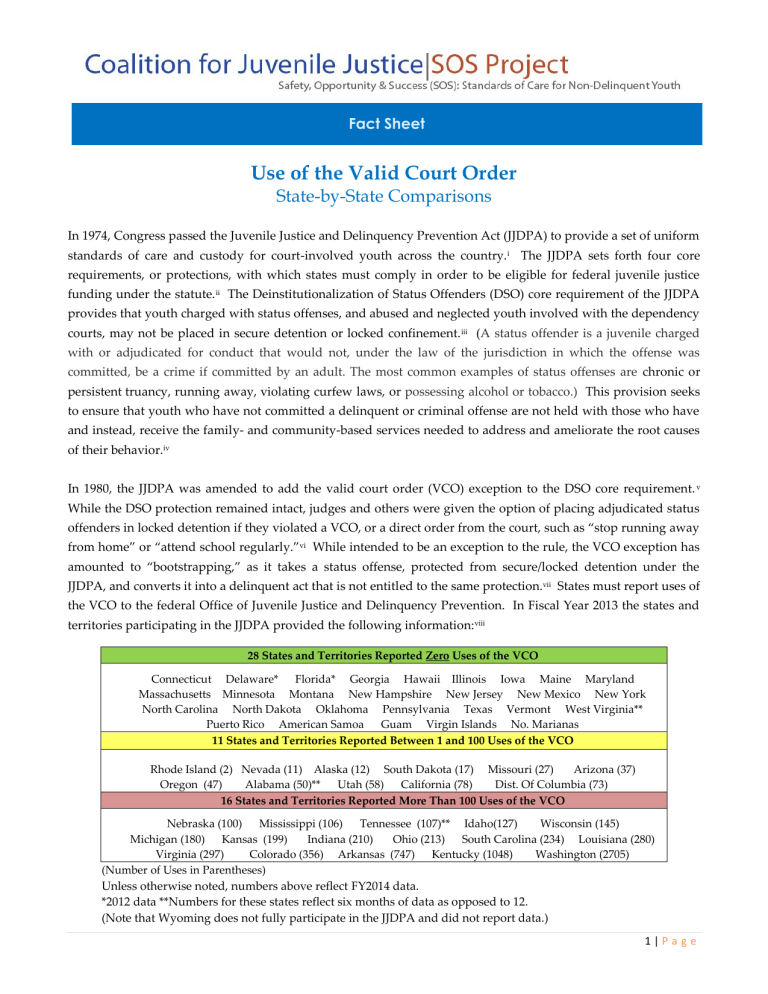Use of the Valid Court Order Exception in the States

Fact Sheet
Use of the Valid Court Order
State-by-State Comparisons
In 1974, Congress passed the Juvenile Justice and Delinquency Prevention Act (JJDPA) to provide a set of uniform standards of care and custody for court-involved youth across the country.
i The JJDPA sets forth four core requirements, or protections, with which states must comply in order to be eligible for federal juvenile justice funding under the statute.
ii The Deinstitutionalization of Status Offenders (DSO) core requirement of the JJDPA provides that youth charged with status offenses, and abused and neglected youth involved with the dependency courts, may not be placed in secure detention or locked confinement.
iii ( A status offender is a juvenile charged with or adjudicated for conduct that would not, under the law of the jurisdiction in which the offense was committed, be a crime if committed by an adult. The most common examples of status offenses are chronic or persistent truancy, running away, violating curfew laws, or possessing alcohol or tobacco.) This provision seeks to ensure that youth who have not committed a delinquent or criminal offense are not held with those who have and instead, receive the family- and community-based services needed to address and ameliorate the root causes of their behavior.
iv
In 1980, the JJDPA was amended to add the valid court order (VCO) exception to the DSO core requirement.
v
While the DSO protection remained intact, judges and others were given the option of placing adjudicated status offenders in locked detention if they violated a VCO, or a direct order from the court, such as “stop running away from home” or “attend school regularly.” vi While intended to be an exception to the rule, the VCO exception has amounted to “bootstrapping,” as it takes a status offense, protected from secure/locked detention under the
JJDPA, and converts it into a delinquent act that is not entitled to the same protection.
vii States must report uses of the VCO to the federal Office of Juvenile Justice and Delinquency Prevention. In Fiscal Year 2013 the states and territories participating in the JJDPA provided the following information: viii
28 States and Territories Reported Zero Uses of the VCO
Connecticut Delaware* Florida* Georgia Hawaii Illinois Iowa Maine Maryland
Massachusetts Minnesota Montana New Hampshire New Jersey New Mexico New York
North Carolina North Dakota Oklahoma Pennsylvania Texas Vermont West Virginia**
Puerto Rico American Samoa Guam Virgin Islands No. Marianas
11 States and Territories Reported Between 1 and 100 Uses of the VCO
Rhode Island (2) Nevada (11) Alaska (12) South Dakota (17) Missouri (27) Arizona (37)
Oregon (47) Alabama (50)** Utah (58) California (78) Dist. Of Columbia (73)
16 States and Territories Reported More Than 100 Uses of the VCO
Nebraska (100) Mississippi (106) Tennessee (107)** Idaho(127) Wisconsin (145)
Michigan (180) Kansas (199) Indiana (210) Ohio (213) South Carolina (234) Louisiana (280)
Virginia (297) Colorado (356) Arkansas (747) Kentucky (1048) Washington (2705)
(Number of Uses in Parentheses)
Unless otherwise noted, numbers above reflect FY2014 data.
*2012 data **Numbers for these states reflect six months of data as opposed to 12.
(Note that Wyoming does not fully participate in the JJDPA and did not report data.)
1 | P a g e
As part of its Safety, Opportunity and Success project, CJJ recently released its National Standards for the Care of
Youth Charged with Status Offenses. The National Standards aim to promote best practices for this population, based in research and social service approaches, to better engage and support youth and families in need of assistance.
Given what we know, the National Standards call for an absolute prohibition on detention of status offenders and seek to divert them entirely from the delinquency system by promoting the most appropriate services for families and the least restrictive placement options for status offending youth.
The National Standards were developed by the Coalition for Juvenile Justice (CJJ) in partnership with the National
Council of Juvenile and Family Court Judges (NCJFCJ) and a team of experts from various jurisdictions, disciplines and perspectives, including juvenile and family court judges, child welfare and juvenile defense attorneys, juvenile corrections and detention administrators, community-based service providers, and practitioners with expertise in responding to gender-specific needs. Many hours were devoted to discussing, debating and constructing a set of ambitious yet implementable standards that are portable, easily understood, and designed to spur and inform state and local policy and practice reforms.
The National Standards build on the original intent of the Juvenile Justice and Delinquency Prevention
Act (JJDPA) and its Deinstitutionalization of Status Offenders core requirement, recent efforts to eliminate the Valid Court Order exception in Congress (S. 3155 and S. 678), and the “safety, permanency and well-being” framework set forth in the Adoption and Safe Families Act of 1997 (ASFA). Like ASFA’s focus on the child’s best interest, the National Standards call for system responses that keep youth and their families’ best interests at the center of the intervention. Individually and collectively, the National Standards promote system reforms and changes in system culture, as well as the workforce needed to ensure adoption and implementation of empirically-supported policies, programs and practices that effectively meet the needs of youth, their families and the community.
For more information contact Lisa Pilnik, Deputy Executive Director, Coalition for Juvenile Justice
202-467-0864, or Pilnik@juvjustice.org, or visit http://www.juvjustice.org/sos .
1319 F Street NW, Suite 402, Washington, DC 20004 i cf . 42 USC § 5602 (2012). ii 42 U.S.C. § 5633(a)(11- 13), (22) 2012. iii 42 U.S.C. § 5633(a)(11) 2012. iv 42 U.S.C. § 5601(a)(10) 2012. v PL 96-509, 1980 S 2441, 94 Stat. 2755 (December 1980). vi cf.
Id. vii Kendall, J. (2007) Juvenile Status Offenses: Treatment and Early Intervention . Chicago: American Bar Ass’n. Retrieved from http://www.americanbar.org/content/dam/aba/migrated/publiced/tab29.authcheckdam.pdf
. vii Office of Juvenile Justice and Delinquency Prevention. FY13-14 Valid Court Order Usage . Available at: http://www.ojjdp.gov/compliance/FY2013-FY%202014VCO-state.pdf
. Last accessed Feb. 18, 2015.
2 | P a g e
